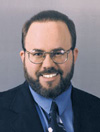A Look at Mintmarks: Part One
Posted on 5/1/2004

Since 1985 (for proof coins) and 1991 (for currency pieces), all mintmarks on United States coins have been an integral part of the design. Sculpted onto the artist's plasticene model, the small letter denoting at which mint a coin was struck is thereby included in each step of the hub- and die-making processes. Since mintmarks had long been the only feature of the die still applied by hand, the resulting coins are now virtually identical.
As indicated, this is a relatively recent development. Traditionally, mintmarks were punched into each working die. This led to numerous varieties resulting from differences in placement, depth and number of punchings. Mintmark puncheons were simply hand tools shaped something like short, thick pencils. Held against the die face, sometimes with the assistance of a jig, the puncheon was tapped with a hammer until the mintmark letter achieved the desired depth in the die. It's easy to see how a slip of the puncheon or a miscalculation in placement required that the die-sinker repeat the process. This may have resulted in repunched mintmarks (two or more overlapping impressions of the same letter) or overmintmarks (when two different punches are used). R. S. Yeoman's familiar reference, A Guide Book of United States Coins, illustrates several examples of each variety, such as the 1943-D/D and 1944-D/S cents.
When the United States had just a single mint in operation, no mintmarks were required. The introduction of branch mints in 1838, however, required that some distinction be made between coins struck at each of these respective facilities. This was done to assure quality control at a time when coins were expected to contain their full value in precious metal. (For our current circulating coins, both dates and mintmarks are unnecessary, but they survive for the sake of tradition and sentiment).
Initially, mintmarks were applied with the same puncheons used for legends and mottoes. Thus, the same size and shape of letter appears on some coins as both the mintmark and part of the inscriptions. This reflects an obsolete method of die preparation, as new designs introduced since 1907 have had their inscriptions sculpted into the artist's model rather than punched into the master die. As the 19th century progressed, new puncheons were created exclusively for use in applying mintmarks, the small letter C punch used on early Carson City Mint issues being an example of this practice.
Most coin types made from 1838 through 1891 show a wide variety of sizes and styles of mintmarks, the Seated Liberty half dollar series being perhaps the richest hunting ground. The Large S used for the earliest San Francisco Mint issues was as large as the coin's legends, while the Micro S that debuted in 1875 was so tiny that it appears often as just an indistinguishable dot. Various sizes between these extremes were used, too, often during the same year. The most dramatic example is 1875, when no less than four distinctive "S" mintmarks were employed. This doesn't imply that the engravers used multiple puncheons to prepare dies within the same year. Instead, the reverse dies were created in batches, each batch employing a particular mintmark puncheon. The reason for so much overlapping of styles for a single date is that the reverse dies were used year after year until they failed. For example, the initial batch of Seated Liberty half dollar reverse dies sent to San Francisco in 1853 featured the Large S, while a later batch sent at the end of 1856 bore the Medium S. Still more dies were shipped in April, 1862, and these featured a Small S. Dies from all three batches were used interchangeably that year, as it mattered not to the mint employees which style was employed.
A common misconception is that mintmarks were applied to the dies at their respective branch mints, but this would have required that each facility have its own set of puncheons. Instead, all dies were prepared and their mintmarks applied at the Philadelphia Mint's Engraving Department. Thus, it was in Philadelphia that all mintmark varieties originated, though they are indelibly linked to the mint which ultimately used the dies.
An attempt to standardize mintmark sizes and style within a given series was initiated with Charles Barber's Liberty Head silver coins of 1892-1916. Each of the three denominations had particular puncheons for the respective mints, and it was not intended that any others be used within that denomination. For the most part this system held, though there are notable exceptions. These include the Micro O half dollar of 1892 and Micro O dime of 1905, both of which utilized the quarter dollar puncheon for just a single reverse die and are quite scarce. The same error occurred with the silver dollar in 1903, when the Small S of the quarter dollar was employed for a single die. The Micro O silver dollars of 1899 appear to have utilized an old dollar reverse from the early 1880s, while the similar but quite poorly made Micro O dollars of 1896, 1900 and 1902 are most likely circulating counterfeits for which genuine coins were used to create transfer dies.
David W. Lange's column USA Coin Album appears monthly in Numismatist, the official publication of the American Numismatic Association.
Stay Informed
Want news like this delivered to your inbox once a month? Subscribe to the free NGC eNewsletter today!
